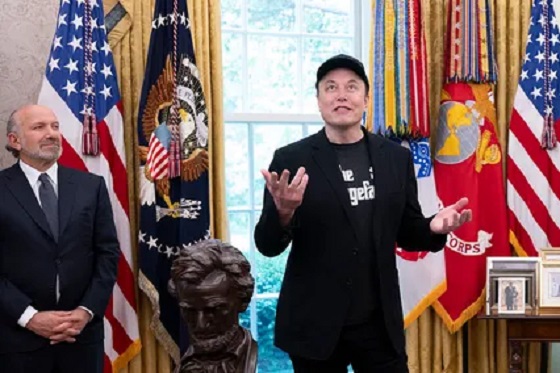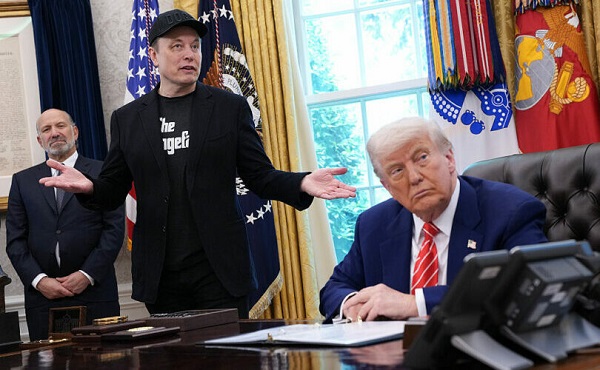Business
Pharma, WHO team up to create permanent ‘pandemic’ market for mandated, experimental vaccines

From LifeSiteNews
By Brenda Baletti, Ph.D., The Defender
Unlimited Hangout journalist Max Jones details how Big Pharma is using the WHO to restructure the drug market, so inadequately tested vaccines and other drugs will face minimal regulation and entire populations can be compelled to take them each time the WHO declares another global pandemic.
Big Pharma and its key investors are rolling out a new strategy — “the full takeover of the public sector, specifically the World Health Organization (WHO), and the regulatory system that now holds the entire market hostage” — according to a new investigative report by Unlimited Hangout’s Max Jones.
What’s behind the new strategy? The pharmaceutical industry is facing a “patent cliff” by 2030, as many of its blockbuster drugs are set to lose their patent protection, placing $180 billion in sales at risk and threatening to topple the industry.
According to Jones, for years, when patents expired on profitable drugs, pharmaceutical giants deployed a “mergers and acquisitions” strategy, buying up smaller drug companies to add to their product portfolios.
As a result, the industry is now dominated by a handful of companies, conventional chemical drugs exist for most health issues, and the regulatory process for new ones has become onerous.
Big Pharma has now pivoted to acquiring biotech and biologic companies, whose products are “more complex, unpredictable and difficult and expensive to make,” than chemical-based medicine, Jones wrote.
Conventional drugs are chemically synthesized and have a known structure according to the U.S. Food and Drug Administration (FDA). Biologics come from living humans, animal or microorganism cells, and are technologically altered to target particular proteins or cells in the immune system. The FDA calls biologics “complex mixtures that are not easily identified or characterized.”
As a drug class, biologics offer an appealing solution to the patent cliff problem, because they can’t be easily replicated like generic versions of conventional drugs.
Instead, producers make “biosimilars,” which unlike genetics can’t simply be interchanged with the original drug during a course of treatment without serious safety risks, according to Jones. And while generics are cheap, biosimilars are still expensive to produce. There also are regulatory hurdles to getting biosimilars to market.
However, Jones wrote, the serious safety issues associated with biologics — the high risk of serious adverse events associated with the COVID-19 vaccine, for example — make it difficult for drugmakers to find commercial success in a conventional regulatory environment.
“Luckily for Big Pharma,” Jones wrote, the WHO and its private backers “are pursuing an unprecedented legal process that would cement loopholes that could solve these significant market challenges of at least some biotechnologies.”
Such loopholes made Pfizer and Moderna’s COVID-19 mRNA vaccines — the paradigmatic example of this new strategy — Big Pharma’s highest-selling annual market success ever.
Distribution of the COVID-19 vaccines to approximately 70% of people globally was possible only because of the “fast-tracked, deregulated development and mandated consumption of the experimental drugs,” Jones wrote.
The industry hopes to replicate that model with other drugs. And it has already begun — last month the Biomedical Advanced Research and Development Authority, or BARDA, gave Moderna $176 million to develop an mRNA bird flu vaccine.
Stakeholders behind the WHO have turned it into an arm of Big Pharma
According to Jones, the process of rapidly developed and mandated experimental drugs was first adopted by the U.S. military for bioweapons threats. Now, it is being internationally legitimized by the WHO through the agency’s revisions to the International Health Regulations (IHR) and its continued attempt to push its pandemic treaty.
The amendments were watered down and the treaty was partially thwarted at the last meeting of the World Health Assembly, which ended on June 1. However, the powers added to the amendments and the language in the treaty WHO and its backers are still hoping to advance next year show the type of biotech pandemic market Big Pharma has in the works.
According to Jones, this market:
Will not be one that depends on the free will of consumers to opt in and out of products — but instead relies on tactics of forced consumption and manipulation of regulatory paradigms.
At the forefront of this push are the WHO’s public-private-partners/private stakeholders, who directly shape and benefit from this policy. Their influence has, in effect, turned the WHO into an arm of Big Pharma, one so powerful that it already demonstrated its ability to morph the entire international regulatory process for the benefit of the pharmaceutical industry during the COVID-19 pandemic.
These stakeholders can wield this power in part because the WHO receives 80% of its funding from private stakeholders.
Those stakeholders include private-sector giants like Bill Gates, his public-private partnership organizations like the Coalition for Epidemic Preparedness Innovations (CEPI) and public-sector bureaucrats, such as Dr. Anthony Fauci and Rick Bright, Ph.D., of BARDA and the Rockefeller Foundation, who have been working for years to create a new system that would speed up vaccine production.
During the COVID-19 pandemic period, even states that lacked legal structures to provide emergency authorization for new drugs created them, using the WHO’s Emergency Use Listing Procedure (EUL) as justification, and aided by the WHO’s COVAX vaccine distribution system. COVAX was co-led by the WHO, Gavi, CEPI and Unicef, which are all backed by Gates.
The goal now, Jones wrote, is to institutionalize the procedures that were put in place globally for COVID-19 to pave the way for a new pandemic market.
The One Health agenda, which requires “full-scale surveillance of the human-animal environment,” both before and during pandemics, is central to this plan, he wrote.
The four pillars of the emerging pandemic market
There are four pillars to the plan for securing this market. The pillars are embodied in the WHO’s recently passed IHR amendments and the proposed pandemic treaty.
1. Biosurveillance of “pathogens with pandemic potential”: The WHO is calling on member states to create infrastructure to conduct biosurveillance on entire populations.
WHO private stakeholders, like the Wellcome Trust and the Bill & Melinda Gates Foundation, have been funding such initiatives for years and continue to be at the forefront of similar initiatives today, Jones wrote.
2. Rapid sharing of data and research: Under the IHR amendments, the WHO’s director-general must provide support for member states’ research and development. In the pending treaty, that would include helping them rapidly share data during a pandemic.
Such sharing should help coordinate global pandemic responses and also “pandemic prevention.” That means building a globally coordinated effort to research and share data on diseases that don’t currently pose a public health threat but are allegedly “likely to cause epidemics in the future.”
The WHO’s announcement last week that it is facilitating data-sharing for a new mRNA bird flu vaccine from Argentina is one example.
Experts have raised concerns that incentivizing such “preventive R&D” could incentivize risky gain-of-function research, Jones wrote.
Jones also noted that it is “highly likely” that the same global organizations that partner with the WHO and are funded by its largest private donors will be the ones doing this research and development on vaccines for “future pathogens with pandemic potential” — and also the ones profiting from it.
3. New regulatory pathways: The WHO is developing new regulatory pathways for unapproved medical products to get to market during pandemic emergencies. The IHR amendments are vague on this, Jones wrote, but the proposed language of the treaty aims to speed up emergency authorizations of WHO-recommended investigational “relevant health products.”
The proposed treaty also seeks to compel member countries to take steps to ensure they have the “legal, administrative and financial frameworks in place to support emergency regulatory authorizations for the effective and timely approval of pandemic-related health products during a pandemic.”
4. Global mandates of unapproved products: The final key element in the Big Pharma-WHO plan to pave the way for a new pandemic market is shoring up the global capacity to mandate unapproved medical products.
According to Jones, in July 2023, the WHO adopted the European Union’s (EU) digital COVID-19 passport system, or the “immunity pass” which recorded people’s vaccination records, negative test results or records of previous infections.
“While a digital vaccine passport does not function as a hard mandate in which every citizen of a given population is forced to take a vaccine, it acts as a conditional mandate — one which offers the illusion of choice, but — in reality — restricts the civil liberties of those who do not comply,” Jones wrote.
The 2005 version of the IHR allowed for travel-based mandates that required proof of vaccination to enter countries when there was a public health risk. The new IHR, Jones wrote, expands on this by detailing the kinds of technology that can be used to check such information during future pandemics.
The WHO also is developing its Global Digital Health Certification Network, which expands the EU digital passport system to a global scale. It will digitize vaccination records and health records and will be “interoperable” with existing networks.
While interoperability makes it possible for decentralized data to be shared globally, Jones wrote, “The UN is seeking to impose digital identification as a ‘human right,’ or rather as a condition for accessing other human rights, for the entire global citizenry by 2030, as established in its Sustainable Development Goal 16.9.”
The initiative seeks to provide people with a “trusted, verifiable way” to prove who they are in the physical world and online.
Verification systems of this size will place the right of citizens to do basic activities — like traveling, eating at a restaurant or working their job — in the hands of governments and potentially employers.
The rights of civilians will be conditional, dictated by data stored in a massive digital hub that is global in its sharing abilities. Not only will domestic governments have access to the health information of their own citizens under this system, but an entire global bureaucracy will as well.
This article was originally published by The Defender — Children’s Health Defense’s News & Views Website under Creative Commons license CC BY-NC-ND 4.0. Please consider subscribing to The Defender or donating to Children’s Health Defense.
Alberta
COWBOY UP! Pierre Poilievre Promises to Fight for Oil and Gas, a Stronger Military and the Interests of Western Canada

Fr0m Energy Now
As Calgarians take a break from the incessant news of tariff threat deadlines and global economic challenges to celebrate the annual Stampede, Conservative party leader Pierre Poilievre gave them even more to celebrate.
Poilievre returned to Calgary, his hometown, to outline his plan to amplify the legitimate demands of Western Canada and not only fight for oil and gas, but also fight for the interests of farmers, for low taxes, for decentralization, a stronger military and a smaller federal government.
Speaking at the annual Conservative party BBQ at Heritage Park in Calgary (a place Poilievre often visited on school trips growing up), he was reminded of the challenges his family experienced during the years when Trudeau senior was Prime Minister and the disastrous effect of his economic policies.
“I was born in ’79,” Poilievre said. “and only a few years later, Pierre Elliott Trudeau would attack our province with the National Energy Program. There are still a few that remember it. At the same time, he hammered the entire country with money printing deficits that gave us the worst inflation and interest rates in our history. Our family actually lost our home, and we had to scrimp and save and get help from extended family in order to get our little place in Shaughnessy, which my mother still lives in.”
This very personal story resonated with many in the crowd who are now experiencing an affordability crisis that leaves families struggling and young adults unable to afford their first house or condo. Poilievre said that the experience was a powerful motivator for his entry into politics. He wasted no time in proposing a solution – build alliances with other provinces with mutual interests, and he emphasized the importance of advocating for provincial needs.
“Let’s build an alliance with British Columbians who want to ship liquefied natural gas out of the Pacific Coast to Asia, and with Saskatchewanians, Newfoundlanders and Labradorians who want to develop their oil and gas and aren’t interested in having anyone in Ottawa cap how much they can produce. Let’s build alliances with Manitobans who want to ship oil in the port of Churchill… with Quebec and other provinces that want to decentralize our country and get Ottawa out of our business so that provinces and people can make their own decisions.”
Poilievre heavily criticized the federal government’s spending and policies of the last decade, including the increase in government costs, and he highlighted the negative impact of those policies on economic stability and warned of the dangers of high inflation and debt. He advocated strongly for a free-market economy, advocating for less government intervention, where businesses compete to impress customers rather than impress politicians. He also addressed the decade-long practice of blocking and then subsidizing certain industries. Poilievre referred to a famous quote from Ronald Reagan as the modus operandi of the current federal regime.
“The Government’s view of the economy could be summed up in a few short phrases. If anything moves, tax it. If it keeps moving, regulate it. And if it stops moving, subsidize it.”
The practice of blocking and then subsidizing is merely a ploy to grab power, according to Poilievre, making industry far too reliant on government control.
“By blocking you from doing something and then making you ask the government to help you do it, it makes you reliant. It puts them at the center of all power, and that is their mission…a full government takeover of our economy. There’s a core difference between an economy controlled by the government and one controlled by the free market. Businesses have to clamour to please politicians and bureaucrats. In a free market (which we favour), businesses clamour to impress customers. The idea is to put people in charge of their economic lives by letting them have free exchange of work for wages, product for payment and investment for interest.”
Poilievre also said he plans to oppose any ban on gas-powered vehicles, saying, “You should be in the driver’s seat and have the freedom to decide.” This is in reference to the Trudeau-era plan to ban the sale of gas-powered cars by 2035, which the Carney government has said they have no intention to change, even though automakers are indicating that the targets cannot be met. He also intends to oppose the Industrial Carbon tax, Bill C-69 the Impact Assessment Act, Bill C-48 the Oil tanker ban, the proposed emissions cap which will cap energy production, as well as the single-use plastics ban and Bill C-11, also known as the Online Streaming Act and the proposed “Online Harms Act,” also known as Bill C-63. Poilievre closed with rallying thoughts that had a distinctive Western flavour.
“Fighting for these values is never easy. Change, as we’ve seen, is not easy. Nothing worth doing is easy… Making Alberta was hard. Making Canada, the country we love, was even harder. But we don’t back down, and we don’t run away. When things get hard, we dust ourselves off, we get back in the saddle, and we gallop forward to the fight.”
Cowboy up, Mr. Poilievre.
Maureen McCall is an energy professional who writes on issues affecting the energy industry.
Business
Carney’s new agenda faces old Canadian problems

From the Fraser Institute
In his June speech announcing a major buildup of Canada’s military, Prime Minister Mark Carney repeated his belief that this country faces a “hinge moment” of the sort the allied countries confronted after the Second World War.
A better comparison might be with the beginning of the war itself.
Then, the Allies found themselves at war with an autocratic state bent on their defeat and possible destruction. Now, Carney faces an antagonistic American president bent on annexing Canada through economic warfare.
Then, Canada rose to the challenge, creating the world’s third-largest navy and landing an army at Normandy on D-Day. Now, Carney has announced the most aggressive reorienting of Canada’s economic, foreign and defence policies in generations.
Polls show strong support among Canadians for this new agenda. But the old Canada is still there. It will fight back. It may yet win.
The situation certainly would have been more encouraging had Carney not inherited Justin Trudeau’s legacy of severe economic and environmental restrictions—picking economic winners and losers rather than letting the market decide—and chronic deficits. The new prime minister would do well to dismantle as much of that legacy as he can.
Some advocate a return to the more laissez-faire approach of Stephen Harper’s government. But Harper didn’t confront a belligerent president hoping to annex Canada through the “economic force” of tariff walls.
The prime minister succeeded in getting Bill C-5, which is intended to weaken at least some of the restrictions on resource development and infrastructure, passed into law. He and the premiers pledge to finally dismantle generations of internal trade and labour mobility barriers. If we must trade less with the Americans, we can at least learn to trade with ourselves.
And the prime minister deserves high praise for reversing decades of military decline through increased spending and efforts to improve procurement. If Carney accomplishes nothing more than restoring Canada’s defences, especially in the Arctic, he will be well remembered.
That said, major challenges confront the Carney agenda.
There’s much talk about a new national energy corridor. But what does that mean? One KPMG executive defined it as a “dedicated, streamlined pathway for the energy, electricity, decarbonization, transportation and digital infrastructure.”
Yes, but what does that mean?
Whatever it means, some First Nations will oppose it tooth-and-nail. Not all of them, mind you. The First Nations Major Project Coalition is dedicated to assisting First Nations in working with government and the private sector for the benefit of all. But many First Nations people consider resource development further exploitation of their ancestral lands by a colonizing power. At the first major proposal to which they do not buy in, they will take the government to court.
What investor will be willing to commit to a project that could be blocked for years as First Nations and Ottawa fight it out all the way to the Supreme Court?
The prime minister, formerly a fervent advocate of combatting climate change, now talks about developing “conventional energy,” which means oil and gas pipelines. But environmental activists will fiercely oppose those pipelines.
There is so much that could go wrong. Sweep away those internal trade barriers? Some premiers will resist. Accelerate housing development? Some mayors will resist. Expand exports to Europe and Asia? Some businesses and entrepreneurs will say it’s not worth the risk.
As for the massive increase in defence spending, where will the money come from? What will be next year’s deficit? What will be the deficit’s impact on inflation, interest rates and sovereign creditworthiness? The obstacles are high enough to make anyone wonder how much, if any, of the government’s platform will be realized. But other factors are at work as well, factors that were also present in 1939.
To execute his mandate, Carney is surrounding himself with what, back in the Second World War, were called “dollar a year men”—executives who came to Ottawa from the private sector to mobilize the economy for wartime.
In Carney’s case he has brought in Marc-André Blanchard as chief of staff and Michael Sabia as clerk of the privy council. Both are highly experienced in government and the private sector. Both are taking very large pay cuts because, presumably, they understand the gravity of the times and believe in the prime minister’s plans.
Most important, Carney’s agenda has broad support from a public that fears for the country’s future and will have little patience toward any group seeking to block the prime minister’s agenda.
Millions of Canadians want this government’s reform efforts to succeed. Those who would put it at risk of failing will have to contend with public anger. That gives Carney a shot at making real change.
-

 Alberta1 day ago
Alberta1 day agoAlberta Next: Immigration
-

 International2 days ago
International2 days agoElon Musk forms America Party after split with Trump
-

 Business2 days ago
Business2 days agoThe Digital Services Tax Q&A: “It was going to be complicated and messy”
-

 Crime17 hours ago
Crime17 hours agoNews Jeffrey Epstein did not have a client list, nor did he kill himself, Trump DOJ, FBI claim
-

 COVID-1915 hours ago
COVID-1915 hours agoFDA requires new warning on mRNA COVID shots due to heart damage in young men
-

 Alberta Sports Hall of Fame and Museum1 day ago
Alberta Sports Hall of Fame and Museum1 day agoAlberta Sports Hall of Fame 2025 Inductee Profiles – Para Nordic Skiing – Brian and Robin McKeever
-

 Indigenous13 hours ago
Indigenous13 hours agoInternal emails show Canadian gov’t doubted ‘mass graves’ narrative but went along with it
-

 Business12 hours ago
Business12 hours agoCarney’s new agenda faces old Canadian problems







